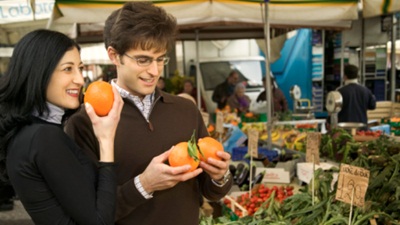
As the catchy pop tune by The Proclaimers goes, they’d “walk 500 miles to wake up next to you.” Would you be willing to walk 100 miles or less to get your food?
If you could, then you might be a locavore—a person that advocates eating locally grown food. The 100-mile diet has gotten a lot of popularity over the past few years, and the premise of the diet is that people will only eat foods using ingredients from within 100 miles of their home.
In fact, it’s also the theme of a new book called The 100-Mile Diet: A Year of Local Eating from non-fiction Canadian writers Alisa Smith and J.B. MacKinnon.
Where our food comes from matters just as much as what is within our food. The authors started in Vancouver, testing the limits of the industrial food system, to determine if they could survive only on food that was grown with a 100-mile radius. If you buy from the supermarket, your food travels between 1,500 and 3,000 miles from the farm to your plate, according to the Leopold Center for Sustainable Agriculture at Iowa State University.
The 100-mile diet is about being consciously aware of the world you’re living in. Here are four benefits of the 100-mile diet.
It’s fresher: From the farm to your table, your food will be much fresher and more nutritious, containing a higher nutrient content than typical store-bought produce that spends time in a warehouse or transport truck before arriving at the supermarket. Locally grown food tends to be picked within 24 hours of your purchase. Between 24 and 48 hours after harvest, 50% to 89% of vitamin C is lost from leafy vegetables.
Increased connection to your food: You can get to know the local farmers and learn where your food comes from, even shake their hand and share a connection with the person who grows what you eat. Be prepared to also meet the gardeners, orchardists, and bakers who all have a hand in bringing you your food.
Your money stays local: You don’t just eat local, but you spend local too. This means that your money stays within your local economy. Farmers receive full value for their product when they sell directly to local customers.
Higher growth standards: A smaller footprint is left on the environment, as small community farms are inclined to follow organic production methods, which are less mechanized, and more bio-diverse. There is definitely energy saved by eating food from within 100 miles of where we live, reducing fossil fuel use from planes that fly food all around the world.
Want to know how you can follow a 100-mile diet? Here’s what you need to know:
Where to get your food: There are plenty of options for local shopping, including purchasing at a local farmer’s market, visiting local farmers, or visiting locally-owned health food or grocery stores for local produce and products. Most of the food will be within the 100-mile radius and within your province or state. If you’re unsure, just ask.
Grow your food: Consider growing your food. Gardening is an essential and cost-effective way for eating locally.
Sources:
Smith, A., et al,, The 100-Mile Diet: A Year of Local Eating (New York: Random House Canada, 2007), 3.
Gabriel, C., “Ten Reasons to Eat Local,” HANS: Health Action Network Society web site, summer 2007; http://www.hans.org/magazine/331/Ten-Reasons-to-Eat-Local.html.
“The Benefits of Eating Locally,” Get Local web site; http://www.getlocalbc.org/.
“The 100-Mile Diet,” Wikipedia web site; http://en.wikipedia.org/wiki/The_100-Mile_Diet, last accessed March 16, 2013.
Tancock, K., “Interview: The 100-Mile Diet,” Canadian Living web site; http://www.canadianliving.com/life/green_living/interview_the_100_mile_diet.php.
“What is a 100 Mile Diet?” wiseGeek web site; http://www.wisegeek.com/what-is-a-100-mile-diet.htm.
Weinberg, R., Holistic Nutritionist (August 6, 2013), personal interview.












